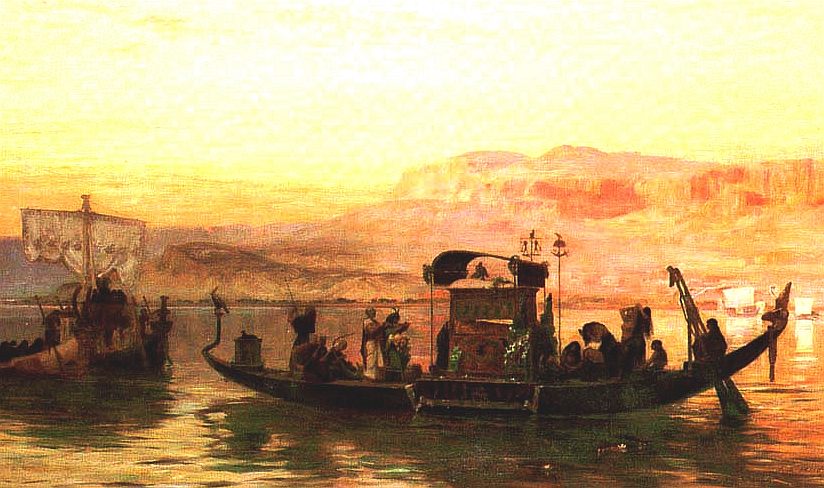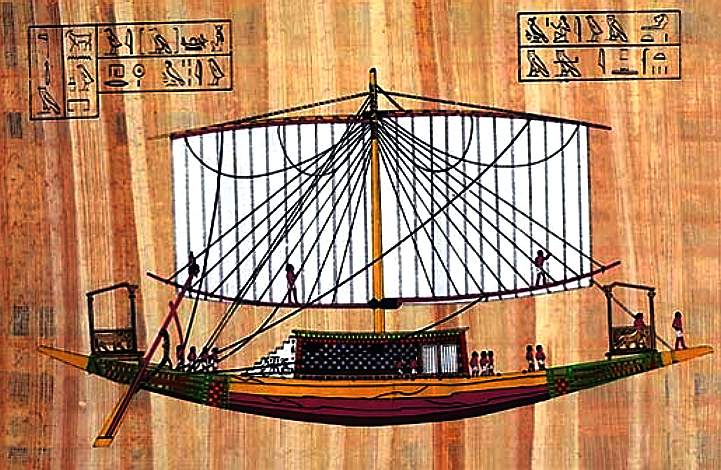|

Golden
death mask of the boy king
The boy king, Tutankhamun, was between eight and nine years of age when he ascended the throne and became pharaoh, taking the throne name Nebkheperure. He reigned for about nine years.
In 1907, Howard Carter was invited by William Garstin and Gaston Maspero to excavate for George Herbert, 5th Earl of Carnarvon in the Valley, who funded the expedition.
Howard Carter discovered the actual tomb of Tutankhamun (KV62) in November 1922.
Tutankhamun was an Egyptian pharaoh who was the last of his royal family to rule during the end of the 18th Dynasty (ruled c. 1332 – 1323 BC in the conventional chronology) during the New Kingdom of Egyptian history. His father is believed to be the pharaoh Akhenaten, identified as the mummy found in the tomb KV55. His mother is his father's sister, identified through
DNA testing as an unknown mummy referred to as "The Younger Lady" who was found in KV35.
Tutankhamun took the throne at eight or nine years of age under the unprecedented viziership of his eventual successor, Ay, to whom he may have been related. He married his paternal half-sister Ankhesenamun. During their marriage they lost two daughters, one at 5–6 months of pregnancy and the other shortly after birth at full-term. His
names - Tutankhaten and Tutankhamun - are thought to mean "Living image of Aten" and "Living image of Amun", with Aten replaced by Amun after Akhenaten's death. A small number of Egyptologists, including Battiscombe Gunn, believe the translation may be incorrect and closer to "The-life-of-Aten-is-pleasing" or, as Professor Gerhard Fecht believes, reads as "One-perfect-of-life-is-Aten".

Tutankhamun restored the Ancient Egyptian religion after its dissolution by his father, enriched and endowed the priestly orders of two important cults and began restoring old monuments damaged during the previous Amarna period. He reburied his father's remains in the Valley of the Kings and relocated the capital from
Akhetaten back to
Thebes. Tutankhamun was physically disabled with a deformity of his left foot along with bone necrosis that required the use of a cane, several of which were found in his tomb. He had other health issues including scoliosis and had contracted several strains of malaria.
The discovery of the tomb in 1922 received worldwide press coverage. With over 5,000 artifacts, it sparked a renewed public interest in
ancient
Egypt, for which Tutankhamun's mask, now in the Egyptian Museum, remains a popular symbol. The deaths of a few involved in the discovery of Tutankhamun's
mummy have been popularly attributed to the
curse of the
pharaohs. He has, since the discovery of his intact tomb, been referred to colloquially as "King Tut".
Some of his treasure has traveled worldwide with unprecedented response. The Egyptian Supreme Council of Antiquities allowed tours beginning in 1962 with the exhibit at the Louvre in Paris, followed by the Kyoto Municipal Museum of Art in Tokyo, Japan. The exhibits drew in millions of visitors. The 1972–1979 exhibit was shown in United States, Soviet Union, Japan, France, Canada, and West Germany. There were no international exhibitions again until 2005–2011. This exhibit featured Tutankhamun's predecessors from the 18th Dynasty, including
Hatshepsut and Akhenaten, but did not include the golden death mask. The treasures 2019–2022 tour began in Los Angeles and
end in 2022 at the new Grand Egyptian Museum in
Cairo, which, for the first time, will be displaying the full Tutankhamun collection, gathered from all of Egypt's museums and storerooms.
NATIONAL
GEOGRAPHIC - LOST TREASURES OF EGYPT SERIES 2021-2022
Mystery of Tut’s Tomb
Archaeologists investigate the mystery of Tutankhamun’s small and poorly decorated tomb. Tutankhamun’s reign was shaped by the life of his father, a pharaoh who led the greatest revolution in Egyptian religious history. Was this revolution, and the political intrigue that followed, the cause of Tutankhamun’s banishment to a tomb unfit for a Pharaoh?
Tutankhamun’s Unsolved Secrets
Archaeologists are on the trail of Tutankhamun. To piece together his story, they search his tomb for secrets missed by the first explorers. Near the site of his quarry, they find evidence of a temple he restored to worship the
crocodile god, Sobek. And beneath a mysterious fortress in the Eastern Desert, they unearth clues to how he amassed enough gold to fill his tomb with unimaginable
treasures.

Lost
treasures of Egypt, one mile from Valley of the Kings
NOTABLE KINGS
Djoser
Khufu
Khafre
Ahmose
Amenhotp I
Thutmose I, II, III
Ramesses I, II III, VI, VIII, IX, X, XI
Amenhotep II
Akhenaten
Tutankamun
Seti I & II
Alexander the Great
Ptolemy I Soter I
Ptolemy IV Philopator
Ptolemy VI Philometor
Ptolemy IX Soter II
NOTABLE QUEENS
Arsinoe II
Cleopatra I, II
Hatshepsut
Sobekneferu
(Neferusobek)
Nefertiti,
beautiful ancient Egyptian queen, architect of the sun cult
Cleopatra
VII
last queen of Egypt
Amina, queen for 34 years in Nigeria
Candace,
Ethiopian Empress, fearsome fighter who resisted Alexander the
Great
Semiramis,
female ruler Assyrian empire.
REFERENCE
https://

CLEOPATRA
THE MUMMY - UNDER DEVELOPMENT
'Cleopatra
- The Mummy' is the part of the John Storm franchise (for which a draft
is available to studios and actor's agents). The John Storm
eco franchise is a series of
ocean awareness adventures, featuring the incredible solar
powered trimaran: Elizabeth
Swann. Cleopatra The Mummy (Cleopatra's Mummy), could be the pilot, with Kulo-Luna
(script available) or Treasure Island as the
sequel/prequel. The
order of production could be to suit identified gaps in
entertainment, in any particular year. Equally, the trilogy,
could be adapted for network television, as with the CBS 'Blood
and Treasure' TV series.
|





